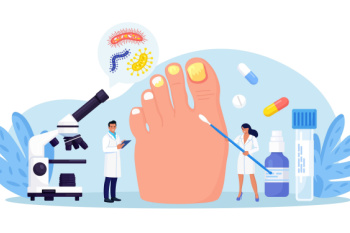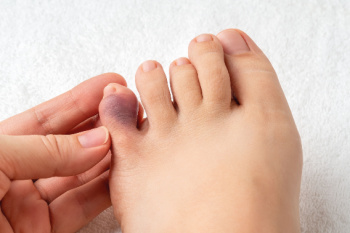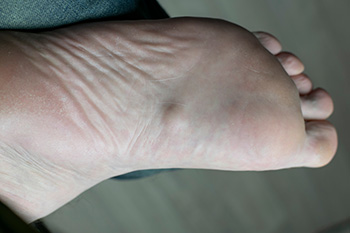Connect With Us
Blog
Items filtered by date: September 2025
Causes and Risk Factors for Toenail Fungus

Toenail fungus, or onychomycosis, is a common condition in which fungi infect the nails, causing thickening, discoloration, and brittleness. It often develops in warm, moist environments such as shoes, locker rooms, and around pools. Risk factors include aging, diabetes, compromised immune systems, nail trauma, and poor foot hygiene. Symptoms may involve yellow or white spots on the nail, crumbling edges, and an unpleasant odor. Without treatment, the infection can spread to other nails or skin. A podiatrist can accurately diagnose toenail fungus, provide effective treatments, and recommend preventive strategies. If you have symptoms of toenail fungus, it is suggested that you contact a podiatrist who can offer effective treatment remedies, which may include prescribed medication.
For more information about treatment, contact Steven Black, DPM of California . Our doctor can provide the care you need to keep you pain-free and on your feet.
Toenail Fungus Treatment
Toenail fungus is a condition that affects many people and can be especially hard to get rid of. Fortunately, there are several methods to go about treating and avoiding it.
Antifungals & Deterrence
Oral antifungal medicine has been shown to be effective in many cases. It is important to consult with a podiatrist to determine the proper regiment for you, or potentially explore other options.
Applying foot powder on the feet and shoes helps keep the feet free of moisture and sweat.
Sandals or open toed shoes – Wearing these will allow air movement and help keep feet dry. They also expose your feet to light, which fungus cannot tolerate. Socks with moisture wicking material also help as well.
If you have any questions please contact our office located in Lancaster, CA . We offer the newest diagnostic and treatment technologies for all your foot and ankle needs.
How to Tell if a Toe Is Broken

A broken toe can happen from something as simple as stubbing it on furniture or dropping a heavy object on the foot. Symptoms often include sharp pain, swelling, bruising, and difficulty walking. The toe may appear crooked or out of alignment, and it may feel tender or numb. In some cases, there may be a popping sound at the time of injury. While some fractures are obvious, others can be mistaken for a sprain. A podiatrist can provide an accurate diagnosis through a physical examination and imaging, such as an X-ray. Treatments vary depending on the severity of the break and may include splinting, buddy taping, protective footwear, or in some cases, surgery. Prompt care can help prevent complications, such as improper healing or long-term pain. It is suggested that you make an appointment with a podiatrist if you suspect a toe may be broken to ensure proper treatment and recovery.
Broken toes may cause a lot of pain and should be treated as soon as possible. If you have any concerns about your feet, contact Steven Black, DPM from California . Our doctor will treat your foot and ankle needs.
What Is a Broken Toe?
A broken toe occurs when one or more of the toe bones of the foot are broken after an injury. Injuries such as stubbing your toe or dropping a heavy object on it may cause a toe fracture.
Symptoms of a Broken Toe
- Swelling
- Pain (with/without wearing shoes)
- Stiffness
- Nail Injury
Although the injured toe should be monitored daily, it is especially important to have a podiatrist look at your toe if you have severe symptoms. Some of these symptoms include worsening or new pain that is not relieved with medication, sores, redness, or open wounds near the toe.
If you have any questions please feel free to contact our office located in Lancaster, CA . We offer the newest diagnostic tools and technology to treat your foot and ankle needs.
Definition and Causes of Plantar Fibromatosis

Plantar fibromatosis, also called Ledderhose disease, is a condition where firm nodules develop in the arch of the foot along the plantar fascia. These growths can cause pain and discomfort while walking or standing. The exact cause is not fully understood, but factors such as genetics, male gender, certain medical conditions like diabetes and liver disease, and repetitive foot trauma may increase the risk. Symptoms often progress slowly and may worsen over time. A podiatrist can help by providing accurate diagnosis, recommending custom orthotics, or other treatment options to relieve pain and improve mobility. If you have a painful nodule in the arch of your foot, it is suggested that you schedule a consultation with a podiatrist for appropriate relief and treatment solutions.
A plantar fibroma may disrupt your daily activities. If you have any concerns, contact Steven Black, DPM of California . Our doctor can provide the care you need to keep you pain-free and on your feet.
Plantar Fibroma
A plantar fibroma is a fibrous knot in the arch of the foot. It is embedded in the plantar fascia which is a band of tissue that extends from the heel to the toes along the bottom of the foot. There can be multiple plantar fibromas in the feet at the same time. There are no known causes for this condition. If you have a plantar fibroma, there will be a bump in the arch of your foot that cannot be missed. Any associated pain is most often due to a shoe rubbing against the nodule. Non-surgical options, such as steroid injections, physical therapy, and orthotics should be tried first. Surgery is a last resort and is the only thing that will remove a plantar fibroma entirely. Consult with a podiatrist for a proper diagnosis and to determine the treatment regimen that is right for you.
What Causes a Plantar Fibroma?
While there are no specific causes identified, a plantar fibroma can possibly come from genetic predisposition or the formation of scar tissue that forms from healing the tears in the plantar fascia.
What Are the Symptoms of a Plantar Fibroma?
There will be a noticeable lump in the arch of the foot that may or may not cause pain. If pain is felt, it is typically because a shoe is rubbing up against the lump or when walking or standing barefoot.
Treatment and Prevention
A plantar fibroma will not disappear without treatment, but it can get smaller and be a non-issue. If pain persists, a podiatrist examines the foot and when the arch of the foot is pressed, pain can be felt down to the toes. An MRI or biopsy might be performed to help diagnose or evaluate the plantar fibroma. The following non-surgical options are generally enough to reduce the size and pain of these nodules:
- Steroid injections
- Orthotics
- Physical therapy to help apply anti-inflammatory creams on the bump
Surgery is considered if the mass increases in size and the patient continues to feel pain after non-surgical methods are tried.
If you have any questions, please feel free to contact our office located in Lancaster, CA . We offer the newest diagnostic and treatment technologies for all your foot care needs.
Gout Pain Can Be Managed
Ways That Diabetes Affects the Feet

Diabetes can have a profound effect on the feet due to its impact on both nerves and circulation. Nerve damage, also called diabetic neuropathy, may reduce the ability to feel pain or temperature changes in the feet. This can allow small injuries, burns, or sores to go unnoticed and worsen over time. The loss of sensation can also lead to structural changes in the bones, joints, and muscles of the feet. Some people may still experience tingling, burning, or sharp pain from nerve involvement. Poor circulation, often linked to narrowed arteries, limits the blood flow needed for healing. This leaves the feet more vulnerable to ulcers or other problems. Infections can spread quickly in feet affected by diabetes and are harder to treat due to slower healing. A podiatrist can identify early warning signs, provide treatment for ulcers or infections, and help prevent severe complications. If you have complications from diabetes that are affecting your feet, it is suggested that you make an appointment with a podiatrist for regular treatment.
Diabetic foot care is important in preventing foot ailments such as ulcers. If you are suffering from diabetes or have any other concerns about your feet, contact Steven Black, DPM from California . Our doctor can provide the care you need to keep you pain-free and on your feet.
Diabetic Foot Care
Diabetes affects millions of people every year. The condition can damage blood vessels in many parts of the body, especially the feet. Because of this, taking care of your feet is essential if you have diabetes, and having a podiatrist help monitor your foot health is highly recommended.
The Importance of Caring for Your Feet
- Routinely inspect your feet for bruises or sores.
- Wear socks that fit your feet comfortably.
- Wear comfortable shoes that provide adequate support.
Patients with diabetes should have their doctor monitor their blood levels, as blood sugar levels play such a huge role in diabetic care. Monitoring these levels on a regular basis is highly advised.
It is always best to inform your healthcare professional of any concerns you may have regarding your feet, especially for diabetic patients. Early treatment and routine foot examinations are keys to maintaining proper health, especially because severe complications can arise if proper treatment is not applied.
If you have any questions, please feel free to contact our office located in Lancaster, CA . We offer the newest diagnostic and treatment technologies for all your foot care needs.
Various Types of Bunions and Different Treatments

Bunions may appear in several ways, each with its own challenges. Some are mild and cause only slight irritation, while others are moderate and with them, the big toe is pushed inward. Severe bunions can create significant pain and limit daily activities. A bunionette, also known as a tailor’s bunion, forms on the outside of the foot near the little toe. Juvenile bunions often develop in younger people and are usually linked to inherited foot structure. Treatment options vary depending on how advanced the bunion is. Simple changes such as wearing wider shoes, applying padding, or using custom orthotics can relieve pressure. More serious bunions may require surgery to correct the alignment and ease discomfort. If you notice a bunion is starting to affect your comfort or mobility, it is suggested that you see a podiatrist who can provide the right diagnosis and treatment plan.
If you are suffering from bunion pain, contact Steven Black, DPM of California . Our doctor can provide the care you need to keep you pain-free and on your feet.
What Is a Bunion?
Bunions are painful bony bumps that usually develop on the inside of the foot at the joint of the big toe. As the deformity increases over time, it may become painful to walk and wear shoes. Women are more likely to exacerbate existing bunions since they often wear tight, narrow shoes that shift their toes together. Bunion pain can be relieved by wearing wider shoes with enough room for the toes.
Causes
- Genetics – some people inherit feet that are more prone to bunion development
- Inflammatory Conditions - rheumatoid arthritis and polio may cause bunion development
Symptoms
- Redness and inflammation
- Pain and tenderness
- Callus or corns on the bump
- Restricted motion in the big toe
In order to diagnose your bunion, your podiatrist may ask about your medical history, symptoms, and general health. Your doctor might also order an x-ray to take a closer look at your feet. Nonsurgical treatment options include orthotics, padding, icing, changes in footwear, and medication. If nonsurgical treatments don’t alleviate your bunion pain, surgery may be necessary.
If you have any questions, please feel free to contact our office located in Lancaster, CA . We offer the newest diagnostic and treatment technologies for all your foot care needs.
Blog Archives
- December 2025
- November 2025
- October 2025
- September 2025
- August 2025
- July 2025
- June 2025
- May 2025
- April 2025
- March 2025
- February 2025
- January 2025
- December 2024
- November 2024
- October 2024
- September 2024
- August 2024
- July 2024
- June 2024
- May 2024
- April 2024
- March 2024
- February 2024
- January 2024
- December 2023
- November 2023
- October 2023
- September 2023
- August 2023
- July 2023
- June 2023
- May 2023
- April 2023
- March 2023
- February 2023
- January 2023
- December 2022
- November 2022
- October 2022
- September 2022
- August 2022
- July 2022
- June 2022

